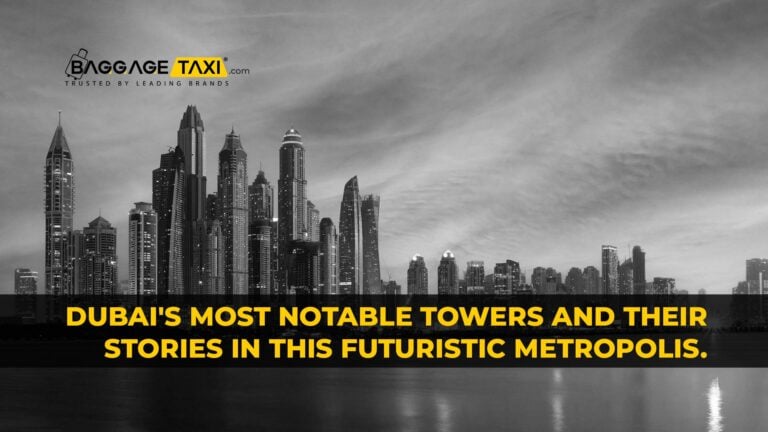
Navigating Dubai’s Skyscrapers and Architecture
Dubai, UAE, is known for its luxury and stunning architecture. This worldwide center on the southeast coast of the Persian Gulf has grown from a little trade port to a vibrant city. Dubai’s skyscrapers, each with a narrative of ambition, invention, and engineering, are iconic. This blog will explore Dubai’s most notable towers and their stories in this futuristic metropolis.
Burj Khalifa: Skytouching
No discussion of Dubai’s architecture is complete without the Burj Khalifa. As the world’s highest structure, it stands at 828 meters. The Burj Khalifa, designed by Adrian Smith, is a feat of human invention and tenacity. Islamic architecture influences its clean, contemporary appearance, blending tradition and modernity.
The 148th and 125th-floor observation decks of the Burj Khalifa provide sweeping views of the city and desert. The Armani Hotel adds elegance to this architectural marvel.
Burj Al Arab: Sailing into Luxury
Dubai’s architectural prowess is not confined to residential and commercial spaces; it extends to redefine the concept of luxury hotels. The Burj Al Arab, often referred to as the “sail of Dubai,” stands as an icon of extravagance and grandeur. This sail-shaped structure is built on its own artificial island and is connected to the mainland by a private bridge.
Designed by Tom Wright, the Burj Al Arab’s architecture is a fusion of modern design and traditional Islamic motifs. The interior is equally opulent, featuring a stunning atrium with golden columns and a lavish color palette. Guests experience unparalleled luxury in its duplex suites, complete with private butlers and breathtaking views of the Arabian Gulf.
Cayan Tower: The Twisted Marvel
Cayan Tower, formerly known as the Infinity Tower, is a residential skyscraper that challenges conventional architectural norms. What sets it apart is its twisted shape, a 90-degree spiral that gives the building a unique and dynamic appearance. This feat of engineering was designed by Skidmore, Owings & Merrill, and it stands as a testament to Dubai’s commitment to pushing the boundaries of architectural innovation.
The twisting structure not only serves an aesthetic purpose but also offers panoramic views of the city and the Dubai Marina. Cayan Tower is a prime example of how Dubai’s architects strive to create buildings that are not just functional but also visually striking.
The Dubai Mall: A Retail Extravaganza
While not a skyscraper in the traditional sense, The Dubai Mall is an integral part of the city’s architectural landscape. As one of the largest shopping malls in the world, it reflects Dubai’s penchant for grandeur and excess. The mall is an architectural marvel that seamlessly integrates retail, entertainment, and leisure.
Designed by DP Architects, The Dubai Mall boasts a diverse range of attractions, including the mesmerizing Dubai Aquarium & Underwater Zoo and the impressive Dubai Ice Rink. The mall’s design incorporates contemporary elements and sustainable features, making it a multifaceted destination that caters to a global audience.
Emirates Towers: Business and Elegance
The Emirates Towers, comprising the Emirates Office Tower and the Jumeirah Emirates Towers Hotel, form a striking duo on Dubai’s skyline. Designed by architect Hazel Wong, these towers are a symbol of the city’s economic prowess and commitment to cutting-edge design. The Emirates Office Tower stands as a testament to Dubai’s flourishing business landscape, housing numerous corporate offices and organizations.
The Jumeirah Emirates Towers Hotel, on the other hand, exudes elegance and sophistication. Its sleek design and modern amenities cater to business travelers and luxury enthusiasts alike. The towers are connected by a central podium that houses a shopping boulevard, further enhancing the integrated nature of Dubai’s architectural planning.
Dubai Frame: Bridging the Past and Future
In a city known for its futuristic architecture, the Dubai Frame stands out as a unique structure that bridges the gap between the past and the future. Located in Zabeel Park, this rectangular frame offers a symbolic view of Old Dubai to the north and the modern skyline to the south.
Designed by award-winning architect Fernando Donis, the Dubai Frame is a testament to Dubai’s commitment to architectural innovation. Its golden cladding and sleek design create a captivating visual spectacle, making it a must-visit attraction for both tourists and residents.
Conclusion
Dubai’s buildings and architecture depict ambition, innovation, and a constant quest of greatness. The city’s advancement and wealth are reflected in each building, from the Burj Khalifa to the Burj Al Arab. Dubai will continue to reinvent itself, adding new architectural wonders to its skyline and establishing its standing as a design and innovation powerhouse. Navigating Dubai’s skyscrapers is a visual feast and a voyage through the collective creativity and dedication that has made the city so amazing.
Recent Posts
Related Posts
Sevices
Partnerships
Payment methods



























